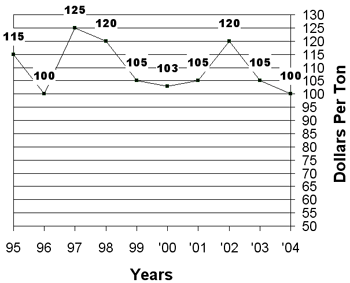Alfalfa Report
Yuma County, Arizona
March 8, 2004
Production Update:
Weed Control: Once temperatures begin to exceed 80º
F. it is difficult to safely use the contact herbicides, Gramoxone and
Buctril. These herbicides are more effective at killing small weeds when
temperatures are high but crop safety is reduced.
Insect Management: Egrets, Ibis, gulls and redwing black
birds are commonly seen in alfalfa fields. Birds are important predators
of various insect pests in alfalfa including the very damaging granulate
cutworm (picture)
. Egrets, Ibis, gulls are often seen at the leading edge of irrigation
water eating crickets and worms forced to move or drown. These birds feed
during the day and roost at night. Therefore, they only eat the cutworms
in lands where water is run during daylight hours. Black birds eat cutworms,
other worm pests and aphids on alfalfa stems.
Total Digestible Nutrients (TDN): TDN is the sum of
digestible nutrients in the forage which includes crude protein, fat,
sugars, starch, and digestible fiber. TDN can be measured directly, but
is most often calculated from a mathematical formula using ADF (acid detergent
fiber) as the sole measured value. TDN and ADF are related to each other,
but this relationship varies by region and is subject to interpretation
by the individual nutritionist.
| Market Summary |
High
|
Low
|
Average
|
Off grade
|
| Past 2 Weeks ( Feb 24 - Mar 8, 2004) | 110
|
90
|
100
|
65-85
|
| Last Year (Feb 24 - Mar 8, 2003) |
110
|
100
|
105
|
80-100
|
10 Year Summary (February 24, to March 8, 1995-2004):

Issued in furtherance of Cooperative Extension work, acts of May 8 and June 30, 1914, in cooperation with the U.S. Department of Agriculture, James A. Christenson, Director Cooperative Extension, College of Agriculture and Life Sciences, The University of Arizona.
The University of Arizona is an equal opportunity, affirmative action institution. The University does not discriminate on the basis of race, color, religion, sex, national origin, age, disability, veteran status, or sexual orientation in its programs and activities.
Any products, services, or organizations that are
mentioned, shown, or indirectly implied in this web document do not imply
endorsement by The University of Arizona.
Information provided by:
Barry Tickes, btickes@ag.arizona.edu Extension Agent, Yuma County
Michael Ottman, mottman@ag.arizona.edu Agronomy Specialist
College of Agriculture, The University of Arizona.
Eric Natwick, etnatwick@ucdavis.edu UCCE Imperial County - Farm Advisor
University of California, Davis, CA.
Forages: Crop Mgmt | Soil Mgmt | Irrigation | Alfalfa Reports | Insects | Diseases | Weeds | Pesticides
Home | Other Crops | Forages
For more Arizona Production Ag Information:
Home | Cotton | Veggies| Forages | Grains | Citrus | Crop x Crop | Insects | Diseases| Weeds | Pesticides | News | Weather | Research | Photos | Contacts | General Info. | Site Map
Copyright © 2001 University of Arizona,
College of Agriculture and Life Sciences
Webmaster: Al Fournier (fournier@ag.arizona.edu)